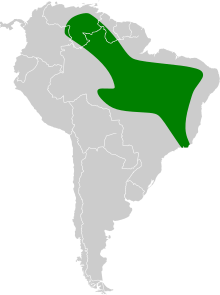Mato Grosso dog-faced bat
The Mato Grosso dog-faced bat (Neoplatymops mattogrossensis), is a bat species from South America. It is found in Brazil, Colombia, Guyana and Venezuela.[1][2]
| Mato Grosso dog-faced bat | |
|---|---|
| Scientific classification | |
| Kingdom: | Animalia |
| Phylum: | Chordata |
| Class: | Mammalia |
| Order: | Chiroptera |
| Family: | Molossidae |
| Genus: | Neoplatymops Peterson, 1965 |
| Species: | N. mattogrossensis |
| Binomial name | |
| Neoplatymops mattogrossensis Vieira, 1942 | |
 | |
| Synonyms | |
| |
Taxonomy and etymology
It was described as a new species in 1942 by C. O. C. Vieira. The holotype had been collected along the Juruena River north of the Brazilian state of Mato Grosso.[3]
Description
It is a small species of free-tailed bat. Its forearm length is 29–30 mm (1.1–1.2 in) and individuals weigh 7–7.5 g (0.25–0.26 oz). It is sexually dimorphic, with males larger than the females. Its skull has a flattened appearance. Its dorsal fur is brown, while its ventral fur is white or gray.[4] Both males and females have gular glands. Its dental formula is 1.1.2.32.1.2.3 for a total of 30 teeth.[3]
Biology and ecology
The Mato Grosso dog-faced bat possibly has a harem social structure. In Venezuela, colonies consist of a single male and two to four females. It is a seasonal breeder, with females giving birth once per year at the beginning of the wet season. It is insectivorous.[3]
Range and habitat
It is found in several countries in South America, including Brazil, Colombia, Guyana, and Venezuela.[1]
Conservation
As of 2008, it is evaluated as a least-concern species by the IUCN—its lowest conservation priority. It met the criteria for this classification because it has a wide geographic range and it is unlikely to be experiencing rapid population decline.[1]
References
- Solari, S. (2019). "Molossops mattogrossensis". IUCN Red List of Threatened Species. 2019: e.T13640A22109057. doi:10.2305/IUCN.UK.2019-1.RLTS.T13640A22109057.en.
- Simmons, Nancy B. (2005), "Chiroptera", in Wilson, Don E.; Reeder, DeeAnn M. (eds.), Mammal Species of the World: A Taxonomic and Geographic Reference (3rd ed.), Baltimore: Johns Hopkins University Press, pp. 312–529, ISBN 978-0-8018-8221-0, retrieved 12 September 2009
- Gardner, A. L. (2008). Mammals of South America, Volume 1: Marsupials, Xenarthrans, Shrews, and Bats. 1. University of Chicago Press. pp. 428–430. ISBN 978-0226282428.
- John F. Eisenberg; Kent H. Redford (2000). Mammals of the Neotropics, Volume 3: Ecuador, Bolivia, Brazil. University of Chicago Press. p. 455. ISBN 978-0-226-19542-1.
